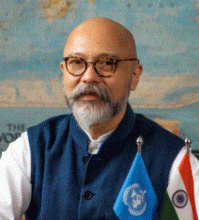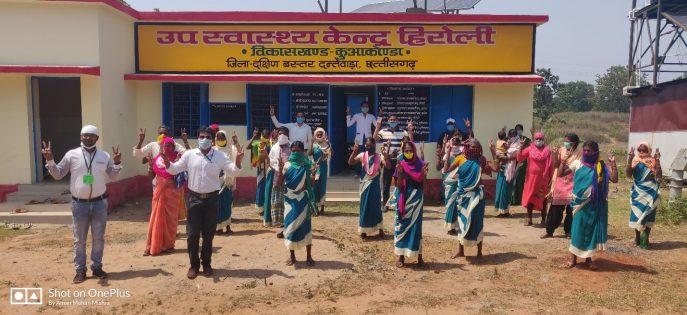In Chhattisgarh State, strengthening a network of health and wellness centres under the Ayushman Bharat programme, is pivotal in providing uninterrupted essential health services particularly during the COVID-19 pandemic.
In this region which has suffered decades of violent conflict, many primary health care services needed improvement. The population is largely vulnerable and there is high prevalence of anemia and noncommunicable diseases. Primary health care is the best way to ensure that they receive the support they need.
In three districts of Bijapur, Dantewada and Sukma, the implementation of India’s ambitious Health and Wellness Centre programme is being strengthened to provide primary health care services to all communities and help advance progress towards universal health coverage.
In association with the District Administration, WHO has provided training support and capacity building to reform primary health care systems to deliver essential health services to vulnerable communities during the time of COVID-19 and beyond.

"WHO India is proud to partner with the Chhattisgarh Government in providing technical mentoring, as a result, policy inputs are working well on the ground. Under the guidance of state government, collaborations between local administrations, WHO and the UHC Partnership are helping expand comprehensive primary health care in Aspirational Districts. Reorganization of essential services during the pandemic is one example of how such partnerships can help health systems in states adapt so that achieving UHC continues even in the most challenging situations."
THE LONG READ
In the Mangalnar village in Bijapur district, Rajeshwari and her husband Gopi conceived a child after ten years of waiting. In early April, during a strict lockdown to combat COVID-19, Rajeshwari went into premature labour. She was just 24 weeks pregnant.
Thanks to the referral network in the district, she was promptly moved to the nearest community health centre where she delivered her baby safely. However, with a birth weight of a meagre 510 grams, the tiny baby’s fight for survival had just begun. After close to three months of care in a sick newborn care unit at a district hospital and tele-mentoring from the experts at the Apex health care institute of the All India Institute of Medical Sciences in Raipur, she became the youngest preterm baby to survive in the region.
“Because of our bitter past we had almost given up hope, but thanks to the tireless efforts of the doctors and nurses, our daughter has miraculously survived,” said Rajeshwari.
The experience of successfully caring for this baby during a crisis such as COVID-19 has boosted the morale of health workers in Bijapur. After discharge, the family came back to the district hospital once for follow-up before moving to a relative’s home in Bhilai, where the baby is doing well.


Maintaining essential services during COVID-19
Bastar region, located in the southern part of Chhattisgarh in central India, is one of the most difficult to reach areas in the country. Six decades of violent insurgency has led to a lack of overall development. This, combined with dense forests, has made many of the areas unserviceable by health care workers. As a result, the region has some of the poorest health indicators in India, lagging behind national averages. But in recent years, the launch of the Transformation of Aspirational District Programme has helped the region make huge leaps in overall development, but the journey has just begun.
As part of its support to the state government of Chhattisgarh, WHO is providing technical expertise to the districts of Bijapur, Dantewada and Sukma in the Bastar region to support and reinforce the Health and Wellness Centre programme. This is part of WHO’s assistance, through the UHC Partnership, to support equitable access to essential health services at sub-national levels, through major reforms to strengthen local health systems including primary health care, with a focus on marginalized groups.

“The proactive partnership between WHO and the state government of Chhattisgarh has been invaluable in progressing towards Universal Health Coverage. Successful continuation of essential health services in some of the most resource-constrained districts during the peak of the COVID-19 pandemic is a testimony of this collaborative approach. With continued technical assistance from WHO and other partners, Chhattisgarh is committed to improving the quality of care while expanding Comprehensive Primary Health Care in the state,” said Dr Priyanka Shukla, Mission Director – National Health Mission, Government of Chhattisgarh.
“WHO India is proud to partner with the Chhattisgarh Government in providing technical mentoring, as a result, policy inputs are working well on the ground. Under the guidance of state government, collaborations between local administrations, WHO and the UHC Partnership are helping expand comprehensive primary health care in Aspirational Districts. Reorganization of essential services during the pandemic is one example of how such partnerships can help health systems in states adapt so that achieving UHC continues even in the most challenging situations,” said Dr Roderico H Ofrin, WHO Representative to India.
The UHC Partnership works in 115 countries and areas to help governments accelerate progress towards UHC through funding provided by the European Union (EU), the Grand Duchy of Luxembourg, Irish Aid, the Government of Japan, the French Ministry for Europe and Foreign Affairs, the United Kingdom – Foreign, Commonwealth & Development Office and Belgium.

In Bijapur, Dantewada and Sukma, up to 70% of women age 15-49 and children under five are anemic. The burden of noncommunicable diseases (NCDs) is steadily rising with up to 8% of men and 7% of women age 15-49 years showing early symptoms of hypertension and diabetes.
Health and Wellness Centres at the PHC level provide a good platform for the expansion of services to prevent and manage these conditions. Since early 2019, with technical support from WHO India, about 50% of existing sub health centres in all three districts have been upgraded to Health and Wellness Centres. This network of recently strengthened facilities are proven to be pivotal in providing uninterrupted essential health services during the COVID-19 pandemic.
The District Administration, with support from WHO, was keen to revitalize health infrastructure in villages affected by decades of violent conflict. Along with meticulous planning, this process demanded wide-scale collaboration between district administration, local community, village leaders and frontline health workers.
Collaborative efforts, coupled with the urgency created by the COVID-19 pandemic, helped make primary health care available in the most far-flung areas. Service delivery at sub health centres in Bedre in Bijapur, Hiroli in Dantewada, and Gachanpalli, Kolaiguda and Minpa in Sukma were revived and strengthened after remaining non-functional for nearly two decades. Each of these centres caters to a population of over 3,000, bringing primary health care closer to these vulnerable local communities.

Capacity building
India has regularly demonstrated its commitment to strengthening its national health care system as well as its pandemic preparedness in order to detect and respond to public health risks, such as COVID-19. Over the past few years, the country has completed different exercises and reports, such as the State Party Self-Assessment Annual Reporting, designed to detect, assess, notify and respond to public health risks.
In the initial weeks of COVID-19, along with fear and confusion in the community, the impact of a nationwide lockdown on essential health services was acute.
The facility-based care was brought almost to a standstill. However, this quiet period provided an opportunity to build the capacity of various cadres of health care workers in infection prevention and control protocols for COVID-19. WHO provided training support in Bijapur and Sukma, both districts facing widespread and severe health worker shortages, and the district administration also trained school teachers in active surveillance of COVID-19. This freed frontline health workers to be able to resume essential health services.
“The contributions of WHO during the COVID-19 pandemic have been immense. From technical support to capacity building, WHO’s support has been indispensable. Collaboration with WHO facilitated strengthening of district health systems for delivering essential health services during the pandemic in addition to the operationalization of quarantine centres, fever clinics, and a dedicated COVID-19 hospital,” said Dr Chandra Bhan Prasad Bansod, Chief Medical and Health Officer and Civil Surgeon, Sukma.

Reorganization of services in response to COVID-19
The recent expansion of services in the form of Health and Wellness Centres and mentoring support from WHO has enabled a much-needed reorganization of health services. Whether it was providing support to the maternal health programme through antenatal care, child immunization or supplying monthly dosages of medicines to patients with NCDs or diabetes, frontline health workers efficiently reorganized services for home-based care.
Armed with training on active surveillance and infection prevention and control protocols from WHO, auxiliary nurse midwives with help from community health volunteers known as ‘mitanins’ increased the frequency of home visits for surveillance of COVID-19 and other health needs.
With support from WHO a health call centre was established in Dantewada to ensure essential health services, and separate fever clinics were established at all secondary and tertiary levels of health facilities in three districts. This helped safeguard health workers from exposure to COVID-19. As a result of efforts to minimize the impact of the pandemic on essential health services, the number of antenatal care registrations in Bijapur, Dantewada and Sukma substantially increased from 1,496 in March 2020 to 2,238 in May 2020.
“Every village we provide services to has quite a few number of migrant workers put in home quarantine, we have to go visit them every day for COVID-19 surveillance. We use this opportunity to visit pregnant women registered with us and inform them that Health and Wellness Centres are fully functioning even in lockdowns so as not to miss date of their antenatal care visits,” said Rashmi Kaware, Community Health Officer, Health and Wellness Centre, Health and Wellness Center Mingachal, Bijapur.

Essential health services at quarantine centres
Another pressing challenge was to screen, detect and to address the health needs of huge numbers of returning interstate migrants. Over a three-month period, the three districts together experienced an influx of approximately 50,000 interstate migrant workers who were accommodated in various quarantine centres. Duty rosters of school health teams, practitioners of Indian traditional medicines known as AYUSH providers, were reorganized to provide COVID-19 screening and essential health services at quarantine centres. WHO provided planning and mentoring support for the reorganization. These crucial actions allowed auxiliary nurse midwives, rural medical assistants and community health officers to use their time for providing essential health services.


Reaching the most marginalized with essential health services
While COVID-19 has inevitably presented new challenges to the people and the health system of Chhattisgarh State, it has galvanized solid local action to reinstate and strengthen primary health care services, building the foundation for UHC. The Government, with technical support and training from WHO, has worked hard to ensure that the whole population, even those in the hardest to reach places, are not left behind.
“Revitalization of the Sub Health Center Hiroli has bought primary health care near the community and now they don’t need to travel 8km for their basic health needs. It will also build the community’s trust in the public health system and motivate health care workers,” said Rajesh Bhera, Rural Health Officer – Sub Health Center Hiroli, Dantewada.
